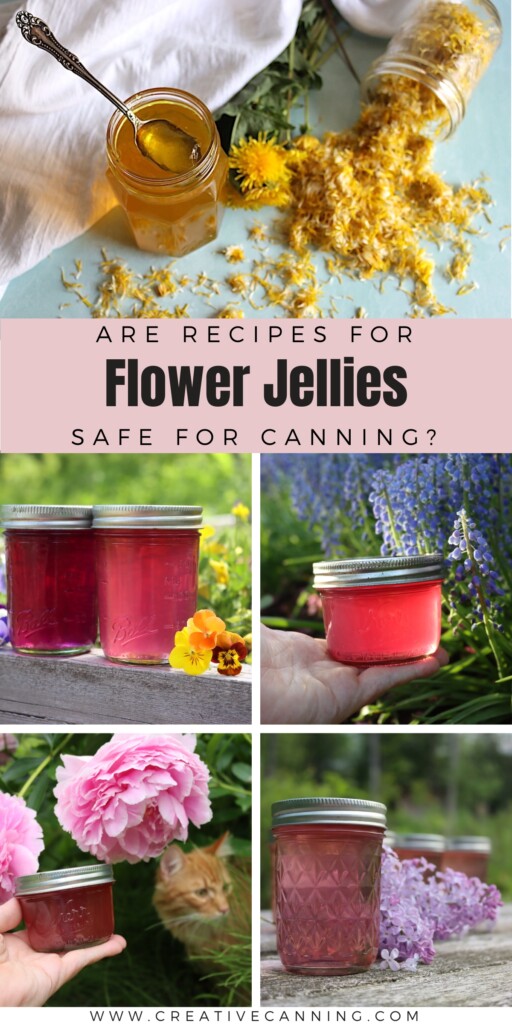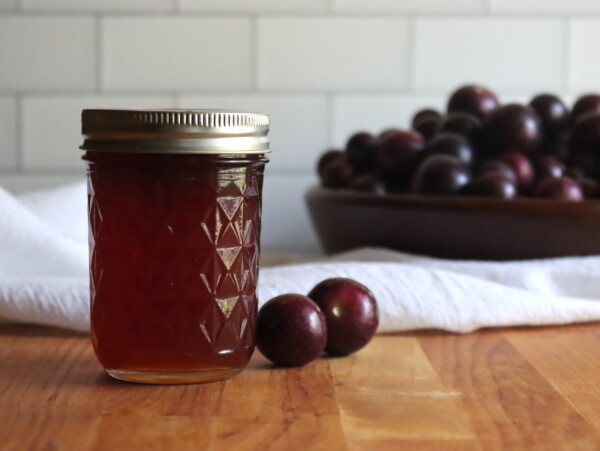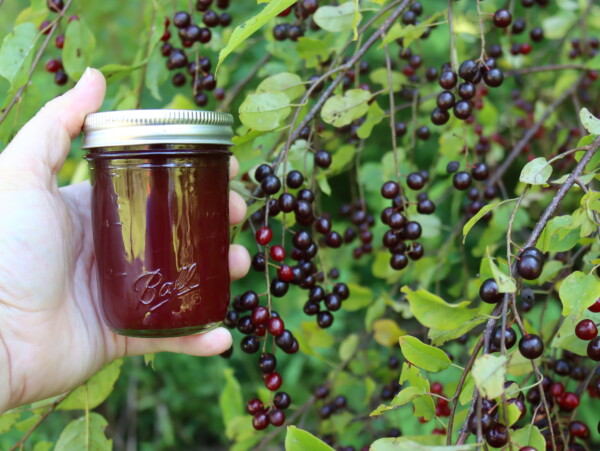This post may contain affiliate links. Please see our disclosure policy.
Canning flower jelly is a beautiful way to preserve the fleeting flavors of spring and summer blooms. While recent controversy has cast doubt on the safety of canning floral jellies, the truth is they’re perfectly safe—when properly acidified. With the right balance of lemon juice and pectin, flower jellies can be just as shelf-stable as any fruit preserve.
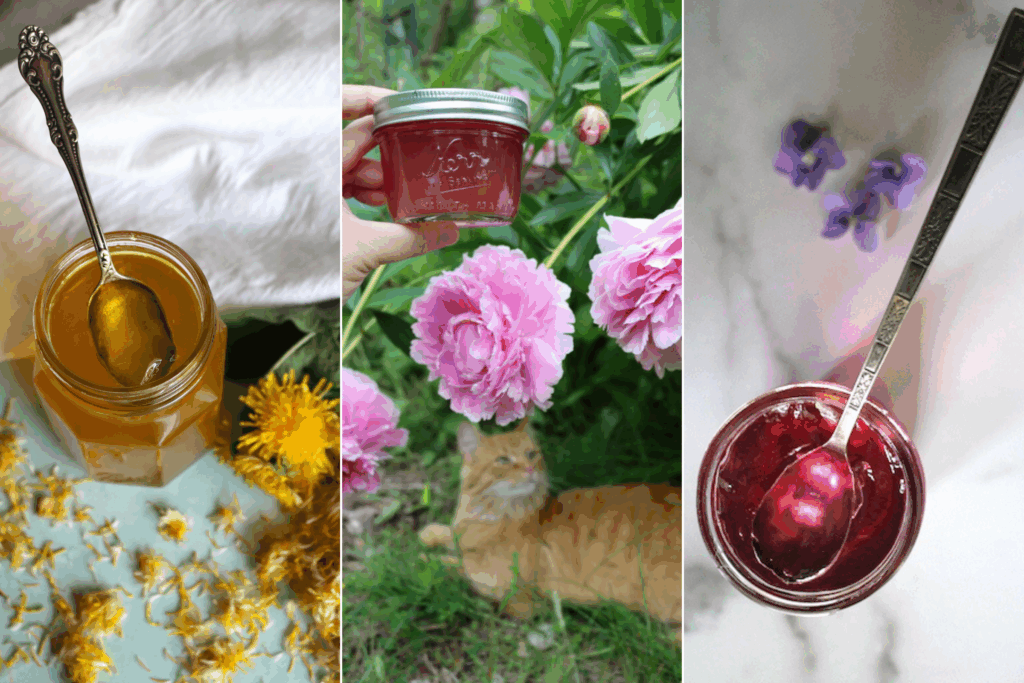
Table of Contents
Dandelion jelly recipes have been around for decades, often passed down through families or printed in university extension bulletins. But recently, one such recipe—previously published by the Wisconsin Extension—was quietly pulled from their website with a retraction stating that there are “no safe recipes for canning flower jellies.” This has understandably caused confusion and frustration among home canners and foragers alike.
So, let’s break it down: Are flower jellies safe to can? Yes—but only when properly acidified.
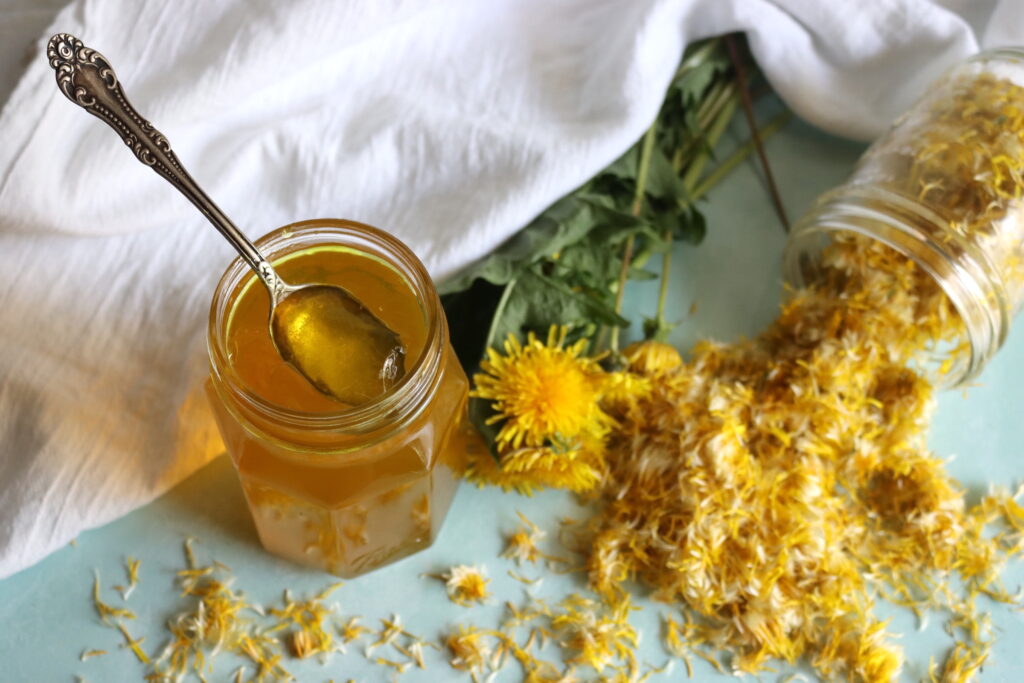
The Source of the Panic
The sudden retraction from Wisconsin Extension stemmed from the realization that their long-standing dandelion jelly recipe did not include any added lemon juice or acidifier. Without that, the pH of the final product is unknown—and possibly unsafe for water bath canning. When pressed, they couldn’t locate testing data to confirm it fell below the safe threshold of pH 4.6, which is required to prevent the risk of botulism.
Out of liability concerns, they issued a blanket statement implying that no flower jellies are safe for canning—despite the fact that several other extensions, national food preservation centers, and commercial pectin companies still publish flower jelly recipes that are completely safe when properly acidified.
The University of Wisconsin did say that they pulled the recipe rather than testing an acidified version because they had concerns about the potential for pesticide use on wildflowers, worried about flower allergies, and were concerned with people accurately identifying the flowers in question. All valid concerns, and obviously you should work with unsprayed flowers and known how to properly ID the plant. But that’s true of any edible flower recipe and has no bearing on canning safety.
They chose not to re-test their long-standing recipe because of concerns about plant misidentification, potential pesticide exposure, and flower allergies—not because flower jellies are inherently unsafe to can when properly acidified.
(The same thing recently happened with pickled garlic canning recipes, where they were pulled not because they’re not properly acidified when pickled, but rather because the large bags of peeled garlic currently coming from China are often tainted or contaminated, and they worry about people putting up large quantities of it. Not because it’s unsafe to can pickled garlic harvested from your backyard.)
This isn’t about flower petals being inherently dangerous, at least with proper ID and when you consciously choose flowers from an unsprayed location. It’s about acid levels—and as you’ll see, this is something we can control.
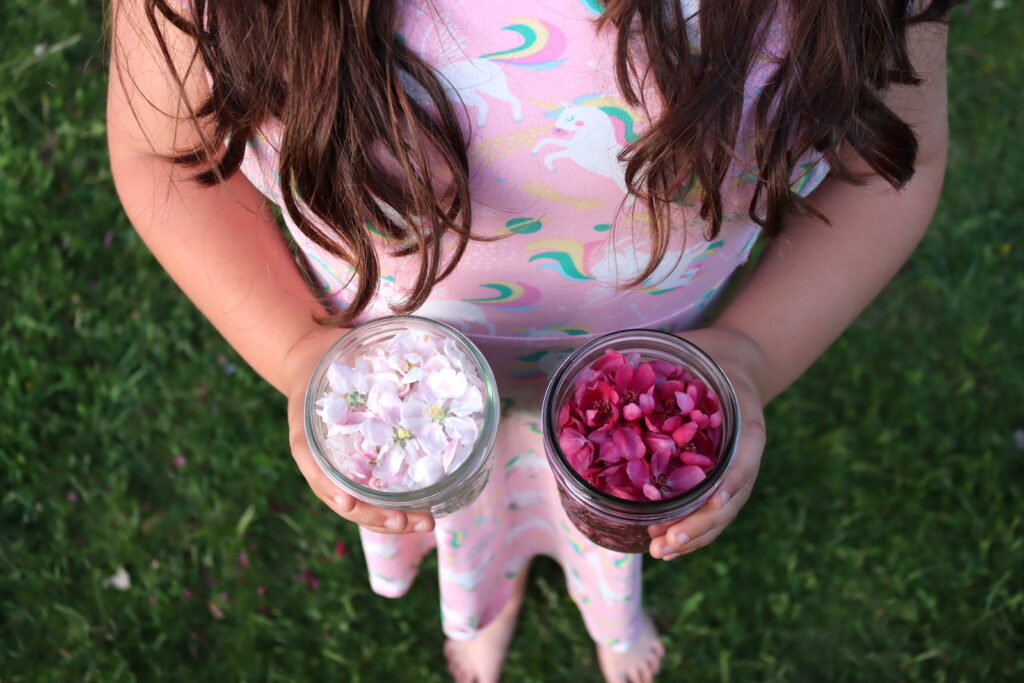
Understanding the Role of Acidity
Acidity is what makes water bath canning safe. When the pH of a preserve is below 4.6, botulism spores can’t grow. Lemon juice, vinegar, or naturally acidic ingredients like wine and certain fruits are what ensure those safe pH levels.
Here’s the good news: flower jellies are made from tea, not from low-acid vegetables like peppers or onions. And even those can be safely canned with a little lemon juice. According to research from the National Center for Home Food Preservation (NCHFP), just 2 tablespoons of lemon juice can safely acidify a whole cup of onions or peppers for salsa.
In a 2004 study titled Studies on safe acidification of salsa for home boiling water canning, the NCHFP found that just 10 ml of lemon juice per 200 grams of low-acid vegetables brought pH below 4.6. (To translate, that’s just 2 tsp of lemon per 1 ½ cups of chopped onions.) That’s for chopped solids—flower tea, by contrast, is a much easier medium to acidify.
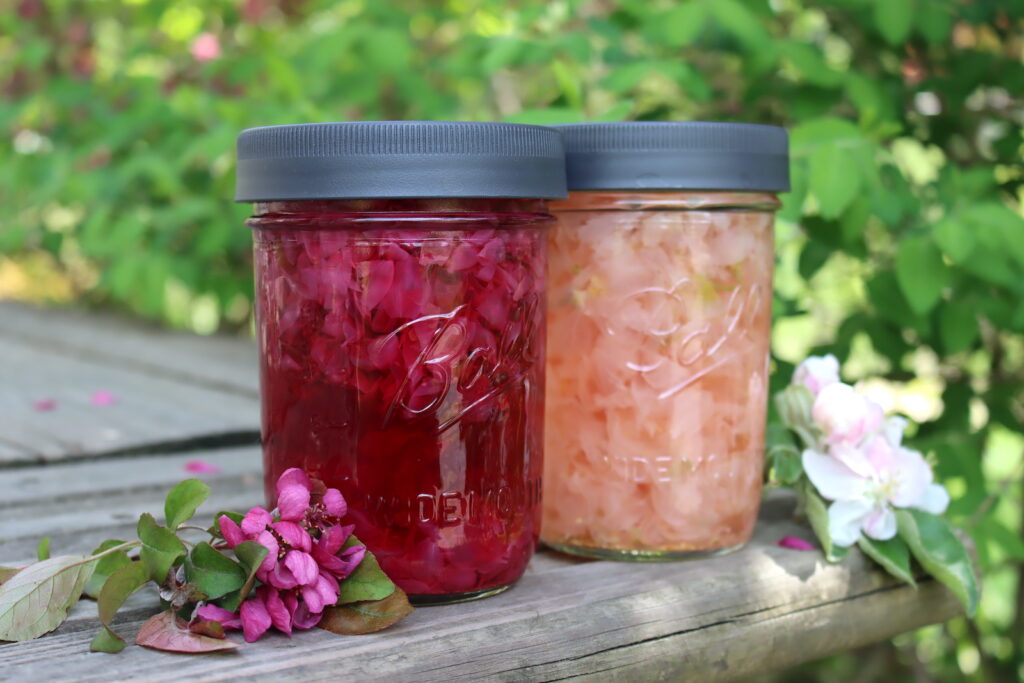
What About Pectin?
Boxed commercial pectin contains citric acid as a setting agent, which also helps to acidify the mixture. Some tested jelly recipes—such as mint jelly and corn cob jelly—don’t include any additional lemon juice, yet they’re still approved for safe canning due to the acidifying effects of boxed pectin.
That said, out of an abundance of caution, I personally always include lemon juice in my floral jelly recipes. Not only does it ensure a margin of safety, it also balances the flavor and adds brightness.
This is especially important because not all boxed pectins contain citric acid anymore—especially some off-brands. Pomona’s Pectin, for example, is completely un-acidified and must be paired with lemon juice. And on the flip side, jellies made with a very low pH can separate or “weep,” so pH management matters for texture as well as safety.
If you’re choosing a pectin for a flower jelly, I’d recommend sticking with Sure Jel, either regular or their low sugar variation, because both set well and have plenty of added citric acid.
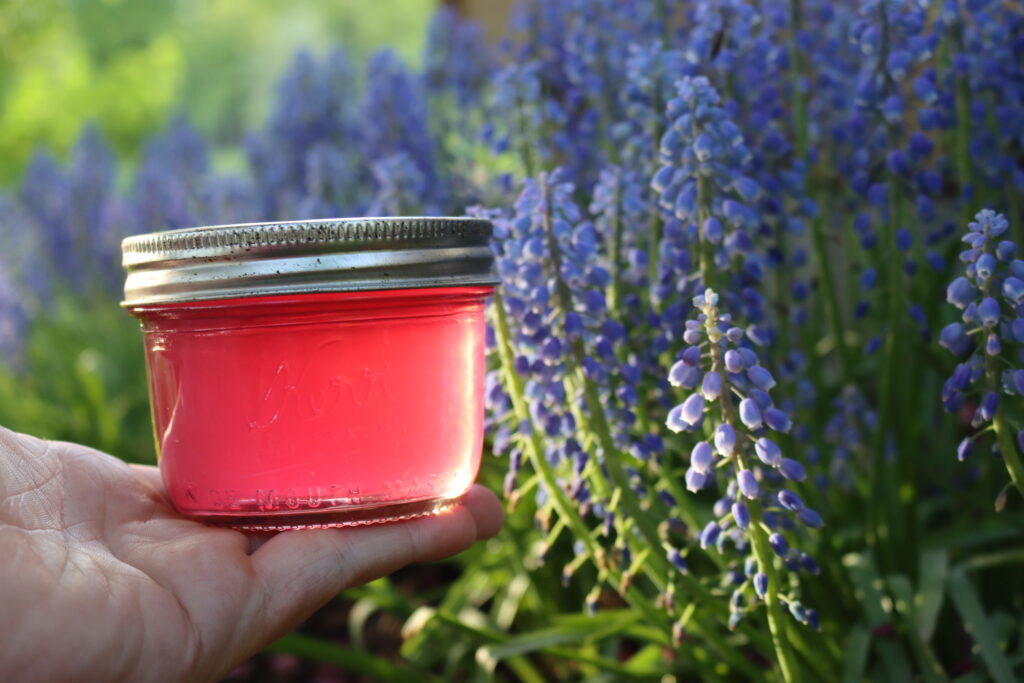
Backed by Trusted Sources
Contrary to what one university extension has recently suggested, there are multiple tested and published flower jelly recipes and similar herb tea based jellies from reputable sources:
- The National Center for Home Food Preservation publishes safe recipes for both mint jelly and corn cob jelly—neither of which include added lemon juice. Corn cob tea is even more alkaline than flower tea, yet it’s safe due to pectin content and sugar levels.
- Colorado State University specifically calls out homemade flower jellies as a way to preserve edible flowers, noting that this method works better than infused oils which will go rancid on the shelf. It goes on to say that edible flowers can be used (and preserved) in all the same ways as herbs, and that all herbs and edible flowers can be used interchangeably in recipes. That includes home-canned jellies, wines, syrups, vinegars, and more. (Source: Colorado State University Extension Fact Sheet 7.237)
- The Ball Blue Book Guide to Preserving specifically notes that herbs and spices can be infused into any jelly to add flavor without impacting canning safety. They’re infused into the liquid and then strained out before finishing the jelly and canning. (Source: Ball Blue Book Guide to Preserving, pg. 44 “Other Ingredients in Soft Spreads”)
- Pomona’s Pectin has a recipe for low sugar violet jelly and another for low sugar rose petal jelly, and they use ½ cup of lemon juice instead of the 2 tablespoons used in recipes with conventional boxed pectin. That’s because pomona’s pectin isn’t acidified and doesn’t contain citric acid, so it needs a bit more bottled lemon juice to ensure proper acidity. The same recipe can be used with rose petals, peonies, sunflower petals, and any other edible flower petal. (Source: Pomona’s Pectin)
- Ball Canning and Bernardin have a recipe for Lavender Wine Jelly, which is made with liquid pectin and no lemon juice. The acidity in the white wine drops the pH of the mixture instead, and the edible flowers are infused directly into the white wine. (Source: Bernardin Lavender Wine Jelly)
- The University of Illinois Extension until recently specifically recommended making jelly from both dandelions and violets, but they removed the information after internal pressure from the University of Wisconsin, not because of any new safety data or testing done by the University of Illinois. (Source: University of Illinois Extension)
- The University of Alaska has published recipes for spruce tip jelly and rose petal jelly, adding 2 Tbsp of lemon juice to 4 cups of flower tea per batch. Those tested recipes are still published in their pamphlets. (Source: Wild Roses, Publication FNH-00114)
Keep in mind, all of these apply to “flower jelly” where the petals are strained out before canning. Not “flower jam” which contains the actual flower petals, which I’ll talk about in a moment.
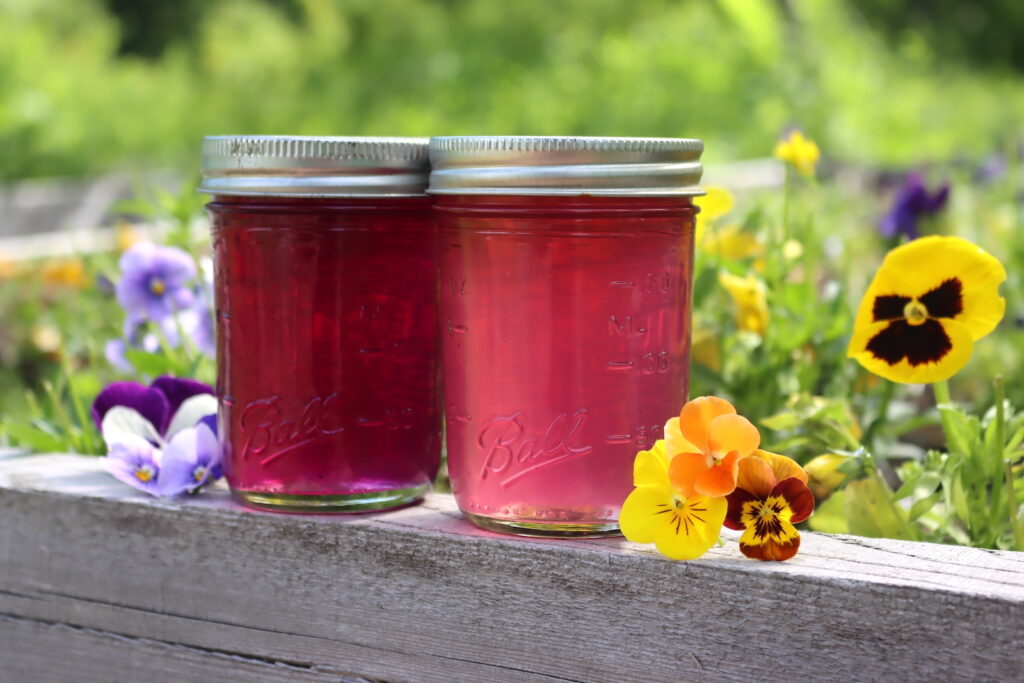
Basic Canning Recipe for Flower Jelly
While the type of flower you use may change the flavor and color, the method for making flower jelly is almost always the same. The base is a simple tea made from edible flower petals, combined with lemon juice, sugar, and pectin to ensure a safe, shelf-stable set. Here’s a reliable starting point:
To make flower jelly, start by measuring out 2 cups of lightly packed edible flower petals (such as dandelion, violet, lilac, or rose). Pour 4 cups of boiling water over the petals and let them steep for at least 15 to 30 minutes, or up to a few hours for stronger flavor. Strain the petals out using a fine mesh sieve or cheesecloth—you should end up with about 3½ to 4 cups of flower tea.
Pour the tea into a saucepan and add 2 tablespoons of bottled lemon juice, then stir in one box (1.75 oz) of powdered pectin. Bring the mixture to a full rolling boil, then add 4 cups of granulated sugar all at once. Return to a boil and cook for 1 to 2 minutes, or until the jelly reaches the gelling point.
Ladle into sterilized jars, leaving ¼ inch headspace. Process in a boiling water bath canner for 10 minutes (or 15 minutes if above 6,000 feet elevation).
This formula works beautifully with a wide range of edible flowers, and if you’re using Pomona’s pectin, you’ll need to follow their instructions instead—which usually means adding ½ cup lemon juice and using calcium water to help it gel.
Once you have the basic technique down, you can start experimenting with floral blends, wine bases, or herbal additions like mint, lemon balm, or thyme—just remember to maintain proper acid ratios and don’t reduce the sugar if you’re using standard pectin.
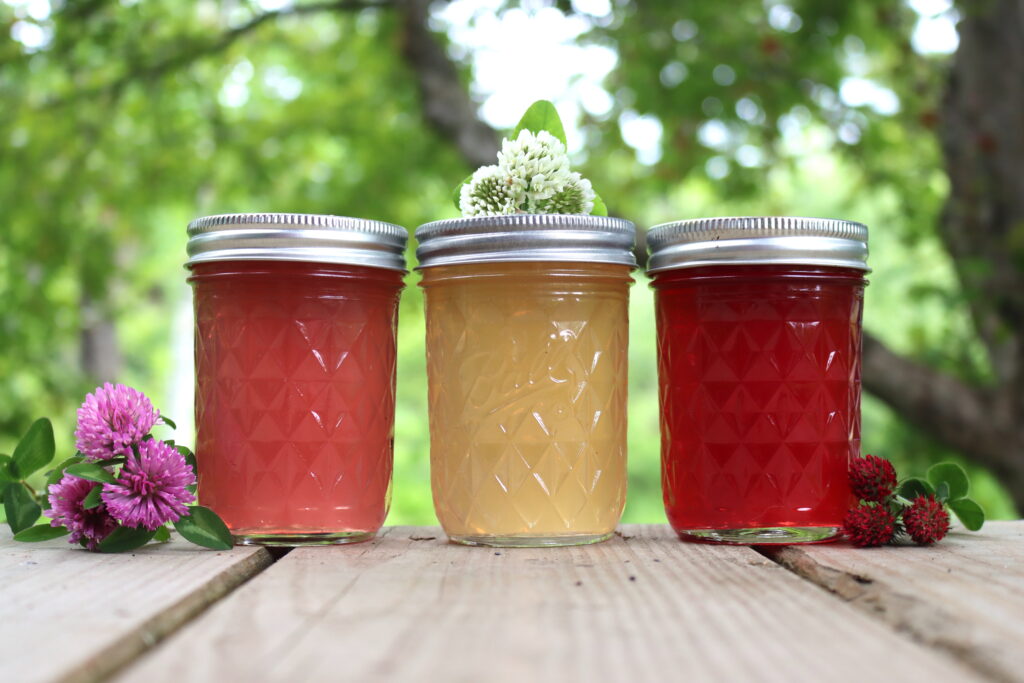
What About Flower Jams?
So while flower jellies are definitely fine for canning, especially with added lemon juice or vinegar, flower jams are not quite as straightforward.
With a flower jam, you’re actually including the flower petals in the mixture, and the preserve would need to be acidic enough to basically “pickle” the flower petals all the way through. There are a number of preserves that have similar characteristics, and they’re suspending things with a high pH in an acidic jelly.
Pepper jellies are one great example. They’re in effect a jellied pickle, odd as that sounds. Most use cider vinegar and then a lot of sugar to balance the flavor.
For a savory herbal jam made with edible flowers, the recipe would work the same way. The recipe will need at least ¼ cup of vinegar per half-pint jar in yield.
The tested recipe below is for a savory herbal jam, and makes about 4 half pint jars:
- 1 to 2 cups edible flowers
- 4 cups water (or 2 cups water and 2 cups white wine)
- 1 to 2 cups sugar
- 1 cup vinegar at 5% acidity (wine vinegar, white, cider, or rice)
- 1/4 cup lemon juice
- 1 box (1.75 ounces) Low Sugar Pectin (such as Sure-Jell)
In this recipe, two cups sugar will get you closer to the sweet tang of a pepper jelly, while 1 cup is more savory, with just enough sugar to cut the acidity.
This, however, is not the “Sweet Flower Jam” that most people are looking for. But as luck would have it, there is another way to solve the acidity problem. Hooray for wine!
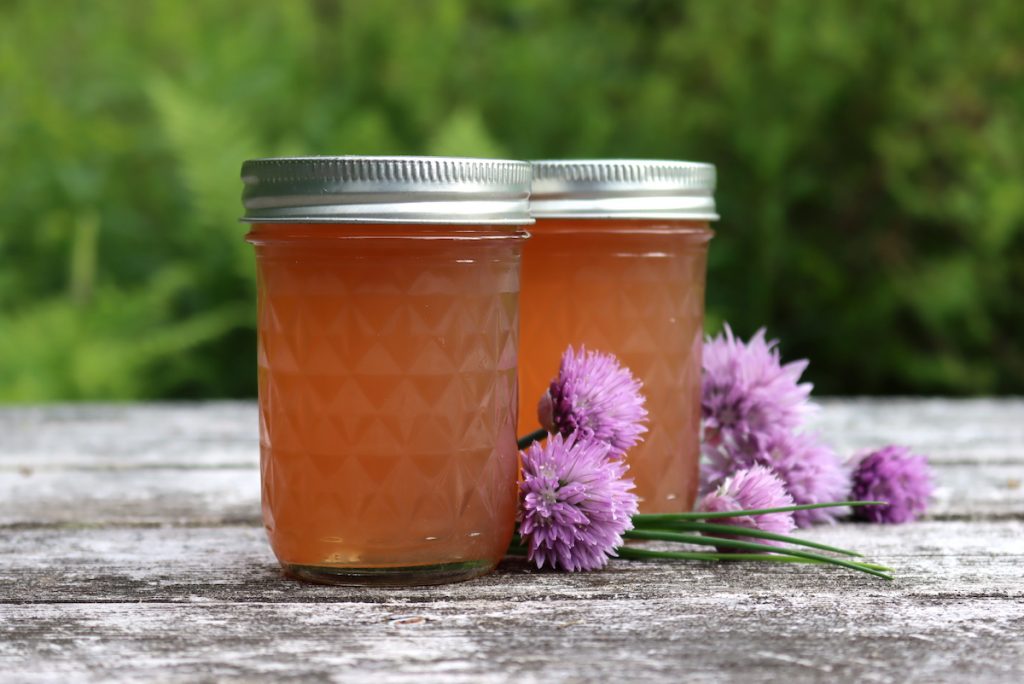
Flower Jams with Wine
Wine is acidic, in fact, it needs to be to create an environment where yeast can thrive but spoilage microbes can’t. If the pH is too high, wines can actually develop botulism toxin too, believe it or not. So, they’re acidic…and they must by definition be below a pH of 4.6.
White wines usually have a pH of around 3 to 3.4, and red wines are usually 3.3 to 3.6. That’s about as acidic as most pickles. White wine gives a neutral base for a jelly, and then you can add in flower petals to the mix.
Bernardin has an all-wine and lemon juice pepper jelly without added vinegar, and that’d make a lovely flower jam. In this case, you’d be substituting flower petals in place of hot peppers and assuming they behave the same in terms of acidity and canning safety. That may not be entirely reliable, so keep in mind that this is not a tested recipe, and you’ll want to test the pH yourself if you choose to try it.
- 1 cup edible flower petals
- 1 1/2 cups (375 ml) sweet white wine
- 3 1/2 cups (875 ml) granulated sugar
- 3 tbsp (45 ml) lemon juice
- 1 pouch (85 ml) Liquid Pectin
You’re already going to have a good bit of citric acid from boxed pectin or liquid pectin, and along with the lemon juice and acidity of the wine, the pH should be well below what’s required for canning safety. (If you use Pomona’s pectin, you’ll need 1/2 cup of lemon juice.)
The edible flowers are used in place of chopped hot peppers, and they should pickle the same…but that’s not guaranteed. As the single not officially tested recipe that I’m referencing here, you’ll have to use your own best judgment (and pH strips) on this one. As noted, the rest of the recipes are tested by known canning authorities for safety.
Traditional Flower Preserves
There are a number of recipes for flower “jams” that are, in fact, syrups or preserves. Those have you cook the flowers in a sugar syrup until they reach the thread stage (235 F), which is much hotter than the setting point of most jellies (220 F).
It thickens, but not because of pectin. Those have such a high sugar content that pH is irrelevant as past a certain point, the sugar itself becomes the preservative, and they’re fine for canning. (Still, they taste better with a bit of lemon juice anyway.)
In effect, you’re making syrup-candied edible flowers that you serve like a “flower jam.” Who cares, it’s delicious!
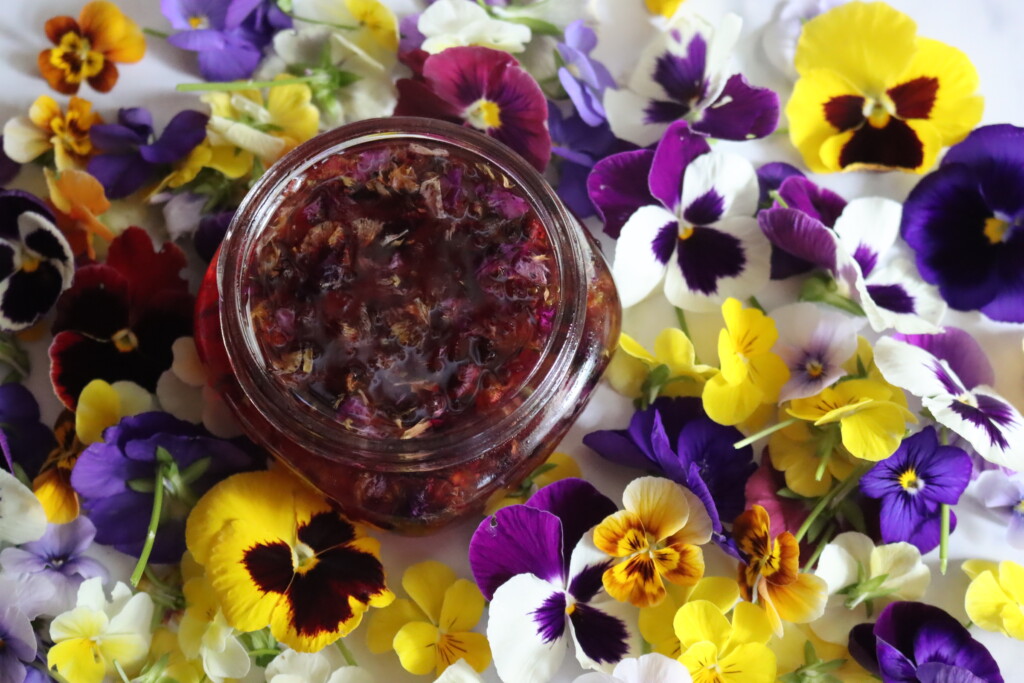
This syrup-based “flower jam” is made and preserved all over the world, and there’s a truly luscious Turkish rose petal jam made this way.
To make a syrup-based flower jam, start with 4 cups of water, 4 cups of sugar, and 2 to 4 cups of edible flower petals. Add it all into a pot, bring the mixture to a boil, and cook until it measures 235 F on a candy thermometer.
Ladle into prepared jars, leaving ¼ inch headspace, and process in a water bath canner for 10 minutes (or 15 above 6,000 feet in elevation).
In other countries, this type of high sugar syrup preserve isn’t canned, it’s just put into sterilized jars and kept in a cool pantry shelf. But, here in the US, we like preserve certainty and going the extra mile to be doubly certain it’s going to keep, so we can it. No matter, it tastes the same…delicious!

Flower Jellies Are Safe—When Done Right
Despite the sudden panic from one extension office, the science—and the recipes—support the safety of properly acidified flower jellies. If you’re using boxed pectin (especially conventional types with citric acid), high sugar content, and a small amount of lemon juice, you’re well within safe home canning guidelines.
So no, flower jellies are not inherently unsafe. They just require the same thoughtful acidification as any other water bath canned preserve. Mint jelly, rose jelly, dandelion jelly—they’re all built on the same principles.
Out of an abundance of caution, you should always add 2 tablespoons of bottled lemon juice per 4 cups of flower tea when using standard boxed pectin like Sure-Jell—or ½ cup lemon juice if using Pomona’s Pectin. There’s nothing inherently dangerous about edible flower petals when harvested responsibly. In truth, they’re not all that different from herbs like mint, which are widely used in safe, tested jelly recipes.
If someone tells you otherwise, feel free to share this post. Because the only thing worse than foodborne illness is fear-based misinformation that keeps us from preserving the beauty and flavor of the season.
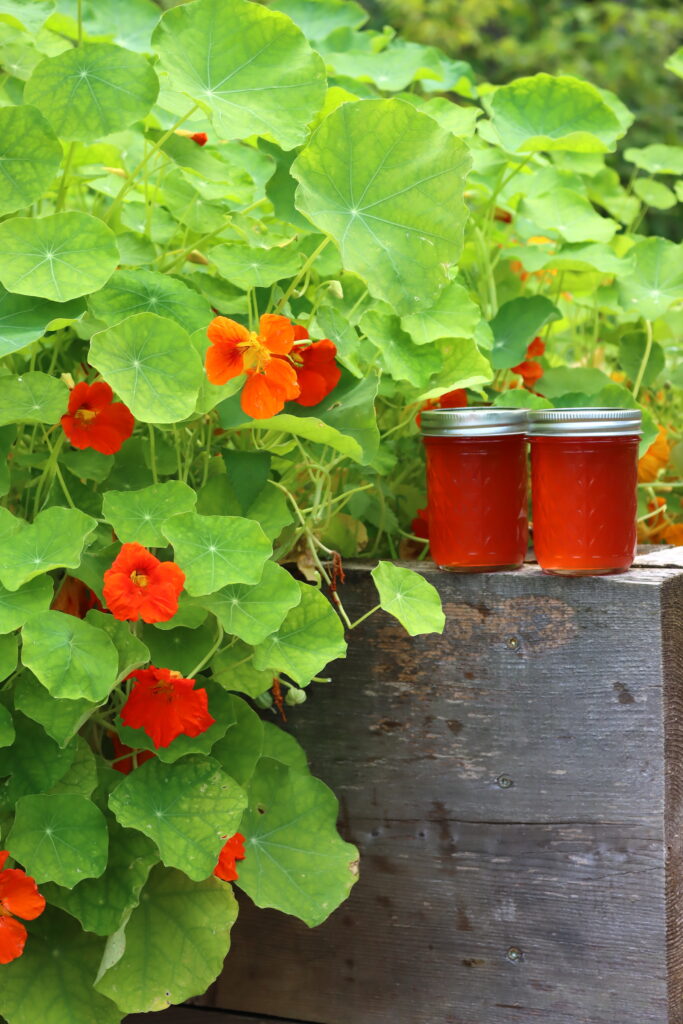
Flower Jelly Recipes
If you’re ready to try your hand at making flower jelly, I’ve shared a wide range of safe, tested recipes that use proper acidification methods for home canning. Dandelion jelly is always a favorite in early spring, and violet jelly captures the delicate flavor and stunning color of wild violets. Later in the season, try lilac jelly, forsythia jelly, or nasturtium jelly, each offering their own unique floral notes. For something more unusual, clover jelly, grape hyacinth jelly, and apple blossom jelly all make beautiful seasonal preserves.
Foragers are especially fond of redbud jelly and elderflower jelly too!
You’ll find all of these in my collection of flower jelly recipes, each one made with added lemon juice and clear canning instructions to ensure safety and flavor.
